|
|
|
Sort Order |
|
|
|
Items / Page
|
|
|
|
|
|
|
| Srl | Item |
| 1 |
ID:
110076


|
|
|
|
|
| Publication |
2012.
|
| Summary/Abstract |
Why do large domestic and multinational enterprises choose one Chinese city over the others in which to set up their company headquarters? What could the Chinese local governments do in order to attract enterprises to establish headquarters in their localities? Following the Chinese commonly used term 'headquarter economy' and investigating the issue mostly from the local governments' perspective, this research examines two cases, Pudong and Shenzhen, to see how they have capitalized on their local advantages and attracted different types of large investments. Both the Pudong and Shenzhen governments provide preferential policies and administrative reforms to build a good investment environment and to develop a 'headquarter economy'. Their preferential policies are similar in design but different in content, so as to attract different target investors. Their administrative reforms are similar in direction but with variations in pace and design for implementation. Our conclusion shows that 'headquarter economy' is a concept flexibly used and wisely adopted by Chinese local governments to develop local economies.
|
|
|
|
|
|
|
|
|
|
|
|
|
|
|
|
| 2 |
ID:
139539
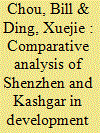

|
|
|
|
|
| Summary/Abstract |
Kashgar, a westernmost city in the restive Xinjiang Uyghur Autonomous Region bordering Central and South Asia, was paired with the southern city of Shenzhen, the most successful special economic zone for its future development. The development of Kashgar’s economy in specific and the Xinjiang in general is a part of China’s new Silk Road project which serves multi-purpose goals, such as narrowing regional disparity, reducing ethnic tensions, fighting terrorism and balancing US pivot to Asia. It is skeptical whether the Shenzhen model can be transplanted into Kashgar. The plan of developing Kashgar’s economy and establishing Kashgar special economic zone may be considered a new bottle with old wine. The development programmes in the past several decades did not address the roots of ethnic tension, including suppression of cultural autonomy and unequal distribution of the benefits and social costs of economic growth. Besides that, the success of the Shenzhen special economic zone is an exception, not a rule. It was unsuccessful in the past attempts to transfer the successful experience from Shenzhen to other special economic zones. It is skeptical whether the Shenzhen experience can be transplanted to Kashgar, whose geographical location and investment environment was much inferior.
|
|
|
|
|
|
|
|
|
|
|
|
|
|
|
|
| 3 |
ID:
136188
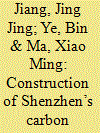

|
|
|
|
|
| Summary/Abstract |
The Shenzhen ETS is the first urban-level “cap-and-trade” carbon emissions trading scheme to operate in China. This paper gives an overview of the economic and emissions situation in Shenzhen and focuses on the development of the Shenzhen ETS regulatory framework. It is devised as an ETS with an intensity-based cap, output-based allocation and a market for trading of allowances. The design of the Shenzhen ETS attaches great importance to coordinate the dynamic relationships between economic growth, industrial transition and emissions control. The cap and its allocation are determined by carbon intensity reduction targets and economic output, with an aim to slow down emissions growth while mitigating shocks from economic fluctuation and industrial adjustment to market stability. The Shenzhen ETS features extensive coverage consisting of three types of regulated entities and four categories of covered emissions, in order to control carbon emissions by both improving energy efficiency and restraining growing energy demand. A competitive game theory method is created for allocation of free allowances to manufacturing enterprises. Mechanisms for carbon offsets and market stabilization are developed to promote active and orderly trading in the carbon market. Moreover, several challenges and their policy choices are detailed for the development of the Shenzhen ETS.
|
|
|
|
|
|
|
|
|
|
|
|
|
|
|
|
| 4 |
ID:
189059


|
|
|
|
|
| Summary/Abstract |
Most urban community studies in China rely on the state–society framework. However, this structural perspective can hardly explain the diverse modes of community governance and their changes over time. This article outlines Shenzhen's 20-year (1999–2019) history of community reform and constructs a framework based on historical institutionalism to analyse Shenzhen's community governance modes over various periods and their changes. First, diversified governance ideas and power structures constructed various community governance modes over this period. Second, community governance mode changes were embedded in local grassroots governance fields. The original governance arrangements, the policy guidance and the ideas of the dominant agencies (the Ministry of Civil Affairs and the Party) at different stages are critical in explaining the transformation of community governance modes. Third, the dominant subject's institutional bricolage within the constraints and empowerment of the institutional context was the critical mechanism of the governance mode transformation. The historical institutionalism framework for community governance transformation provides a new direction for understanding community reform and evaluating evolving local state–society relations.
|
|
|
|
|
|
|
|
|
|
|
|
|
|
|
|
| 5 |
ID:
171087
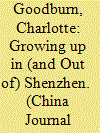

|
|
|
|
|
| Summary/Abstract |
Extensive research has shown that rural-to-urban migrant children in China face significant barriers to an urban public primary school education and often end up in poor-quality, migrant-run private schools. However, much less is known about what happens after children leave junior high school. This article therefore draws on two rounds of interviews with migrant children educated in Shenzhen, in 2008–9 and then in 2015–16, to examine in detail their experiences of schooling and labor-market entry. It identifies four distinct pathways of education—state vocational school, private migrant secondary school, state academic high school, and return to the countryside for further schooling—and suggests that these educational routes all ultimately lead to the same endpoint: regardless of pathway, aptitude, financial investment in education, and earlier career aspirations, migrant youths are channeled into low-skilled urban service work. This is in marked contrast to the hopes of parents that their children will achieve upward mobility through investment in education. This article analyzes the multiple reasons for the depressing uniformity of outcomes and the crucial role of state policy at both the central and local levels in perpetuating migrant disadvantage.
|
|
|
|
|
|
|
|
|
|
|
|
|
|
|
|
| 6 |
ID:
124163
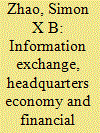

|
|
|
|
|
| Publication |
2013.
|
| Summary/Abstract |
Over the past several years, China has consistently maintained economic growth and at the same time emerged as a new global giant in the international arena, despite the distractions caused by the global financial crisis, which was triggered by the US Sub-prime Mortgage Crisis of 2007 and the recent bond crisis that emerged in the European Union in 2011. Concurrent with China's growing interaction with the global economy and robust growth of its domestic economy, competition for the status of national and even international financial centers in the region has become fierce. This study focuses on a 'local' examination of internal conditions for the emergence and growth of Chinese financial centers over the next 10-20 years. Cities contending for the top slot in the roster of Chinese cities, like Beijing, Shanghai and Shenzhen, are striving to become international financial centers and are trying to compete with Hong Kong. This study investigates the development potentials, future prospects and division of functions between different financial centers within China regarding Hong Kong, Beijing and Shanghai, with special reference to the role of information and locations of MNCs' regional headquarters.
|
|
|
|
|
|
|
|
|
|
|
|
|
|
|
|
| 7 |
ID:
147747


|
|
|
|
|
| Summary/Abstract |
The author analyzes specific features of integration processes in Southeastern part of Guangdong province (PRC) in recent years. He examines the correlation of the economy scope of three parts of the Delta - Guangzhou, Shenzhen, and Zhuhai. The article contains data on the foreign trade of nine cities of the Delta. It shows the leading role of Shenzhen in economic ties of the region with Hong Kong.
|
|
|
|
|
|
|
|
|
|
|
|
|
|
|
|
| 8 |
ID:
156264


|
|
|
|
|
| Summary/Abstract |
Using data from a survey of rural migrants of P district in Shenzhen in 2013, this article explores marital violence among rural migrants. It investigates whether immigrants who witnessed interparental violence or experienced physical violence during childhood are more likely to be emotionally or physically violent in their own marriage. It also finds that the prevalence of mutual violence between rural migrant couples is significantly higher than unilateral violence, and emotional violence is the most common type of marital violence. Witnessing interparental violence in childhood increases the likelihood in adulthood of perpetrating both emotional and physical violence for females but only of emotional violence for males. There is a correlation between experience of physical abuse during childhood and perpetration of physical or emotional abuse during adulthood.
|
|
|
|
|
|
|
|
|
|
|
|
|
|
|
|
| 9 |
ID:
115848


|
|
|
| 10 |
ID:
107908


|
|
|
| 11 |
ID:
118512
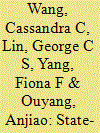

|
|
|
| 12 |
ID:
122640
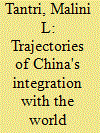

|
|
|
|
|
| Publication |
2013.
|
| Summary/Abstract |
By exploring the role of Special Economic Zones (SEZs) in China's integration with the world economy, we also investigate the underlying challenges faced by the economy. This analysis suggests that SEZs enabled the Chinese economy to trigger its growth standards and to achieve its ambition of integrating with the world economy without compromising its political ideology. This transformation, however, has been accompanied by a few challenges of late that have been posing obstacles to the broader process of development. We argue that the experience of Chinese SEZs provides a number of policy directions for other economies, which may be followed with discrimination.
|
|
|
|
|
|
|
|
|
|
|
|
|
|
|
|
| 13 |
ID:
153345


|
|
|
|
|
| Summary/Abstract |
How has social work, which has emerged as a distinct profession in the PRC with the full support of the party-state, come to produce neoliberal outcomes similar to those found in other, capitalist countries? In this article, I draw attention to the government purchase (goumai) of social work services, which is commonly considered as confirmation of state capacity and leadership rather than the passing on of state responsibilities to civil sectors with tight budgets. Ethnographic research on the actual social work practices in Shenzhen's Foxconn town reveals how neoliberal-style outsourcing has converged with diverse historical legacies, thus creating precarious labour conditions for frontline social workers. Neoliberal dynamics end up filling most of these social work positions with migrant youth from the countryside, reproducing and perpetuating China's rural–urban divide. Institutional efforts at social care may not only reduce the existing inequalities but may also rely upon and even reinforce them.
|
|
|
|
|
|
|
|
|
|
|
|
|
|
|
|
|
|
|
|
|